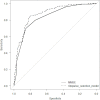The combination of MMSE with VSRAD and eZIS has greater accuracy for discriminating mild cognitive impairment from early Alzheimer's disease than MMSE alone
- PMID: 33617587
- PMCID: PMC7899318
- DOI: 10.1371/journal.pone.0247427
The combination of MMSE with VSRAD and eZIS has greater accuracy for discriminating mild cognitive impairment from early Alzheimer's disease than MMSE alone
Abstract
Background: Alzheimer's disease (AD) is assessed by carefully examining a patient's cognitive impairment. However, previous studies reported inadequate diagnostic accuracy for dementia in primary care settings. Many hospitals use the automated quantitative evaluation method known as the Voxel-based Specific Regional Analysis System for Alzheimer's Disease (VSRAD), wherein brain MRI data are used to evaluate brain morphological abnormalities associated with AD. Similarly, an automated quantitative evaluation application called the easy Z-score imaging system (eZIS), which uses brain SPECT data to detect regional cerebral blood flow decreases associated with AD, is widely used. These applications have several indicators, each of which is known to correlate with the degree of AD. However, it is not completely known whether these indicators work better when used in combination in real-world clinical practice.
Methods: We included 112 participants with mild cognitive impairment (MCI) and 128 participants with early AD in this study. All participants underwent MRI, SPECT, and the Mini-Mental State Examination (MMSE). Demographic and clinical characteristics were assessed by univariate analysis, and logistic regression analysis with a combination of MMSE, VSRAD and eZIS indicators was performed to verify whether the diagnostic accuracy in discriminating between MCI and early AD was improved.
Results: The area under the receiver operating characteristic curve (AUC) for the MMSE score alone was 0.835. The AUC was significantly improved to 0.870 by combining the MMSE score with two quantitative indicators from the VSRAD and eZIS that assessed the extent of brain abnormalities.
Conclusion: Compared with the MMSE score alone, the combination of the MMSE score with the VSRAD and eZIS indicators significantly improves the accuracy of discrimination between patients with MCI and early AD. Implementing VSRAD and eZIS does not require professional clinical experience in the treatment of dementia. Therefore, the accuracy of dementia diagnosis by physicians may easily be improved in real-world primary care settings.
Conflict of interest statement
Norio Yasui-Furukori has been a speaker for Dainippon Sumitomo Pharmaceutical, Mochida Pharmaceutical, and MSD. Kazutaka Shimoda has received research support from Meiji Seika Pharma Co., Pfizer Inc., Dainippon Sumitomo Pharma Co., Ltd., Daiichi Sankyo Co., Otsuka Pharmaceutical Co., Ltd., Astellas Pharma Inc., Novartis Pharma K.K., Eisai Co., Ltd., Takeda Pharmaceutical Co., Ltd. and honoraria from Mitsubishi Tanabe Pharma Corporation, Meiji Seika Pharma Co., Ltd., Dainippon Sumitomo Pharma Co., Ltd., Takeda Pharmaceutical Co., Shionogi & Co., Ltd., Daiichi Sankyo Co., Pfizer Inc. and Eisai Co., Ltd. The companies had no role in the study design, the data collection or analysis, the decision to publish, or the preparation of the manuscript. The remaining authors declare that they have no competing interests to report. This does not alter our adherence to PLOS ONE policies on sharing data and materials.
Figures
Similar articles
-
[Analysis of brain perfusion single-photon emission tomography images using an easy Zscore imaging system for early diagnosis of Alzheimer's disease].Nan Fang Yi Ke Da Xue Xue Bao. 2021 Jul 20;41(7):1093-1100. doi: 10.12122/j.issn.1673-4254.2021.07.19. Nan Fang Yi Ke Da Xue Xue Bao. 2021. PMID: 34308862 Free PMC article. Chinese.
-
Diagnostic utility and characteristics of CT-based attenuation correction in brain perfusion SPECT/CT in predicting the exacerbation of Alzheimer changes from mild cognitive impairment utilizing voxel-based statistical analysis in comparison with Chang's method.Ann Nucl Med. 2020 Jul;34(7):502-511. doi: 10.1007/s12149-020-01477-4. Epub 2020 May 24. Ann Nucl Med. 2020. PMID: 32449110
-
A comparative study: visual rating scores and the voxel-based specific regional analysis system for Alzheimer's disease on magnetic resonance imaging among subjects with Alzheimer's disease, mild cognitive impairment, and normal cognition.Psychogeriatrics. 2019 Mar;19(2):95-104. doi: 10.1111/psyg.12370. Epub 2018 Oct 1. Psychogeriatrics. 2019. PMID: 30276926
-
Is the Montreal Cognitive Assessment (MoCA) screening superior to the Mini-Mental State Examination (MMSE) in the detection of mild cognitive impairment (MCI) and Alzheimer's Disease (AD) in the elderly?Int Psychogeriatr. 2019 Apr;31(4):491-504. doi: 10.1017/S1041610218001370. Epub 2018 Nov 14. Int Psychogeriatr. 2019. PMID: 30426911
-
Digital Clock and Recall is superior to the Mini-Mental State Examination for the detection of mild cognitive impairment and mild dementia.Alzheimers Res Ther. 2024 Jan 2;16(1):2. doi: 10.1186/s13195-023-01367-7. Alzheimers Res Ther. 2024. PMID: 38167251 Free PMC article. Review.
Cited by
-
Relationship Between Vitamin D Status and Brain Perfusion in Neuropsychiatric Lupus.Nucl Med Mol Imaging. 2022 Jun;56(3):158-168. doi: 10.1007/s13139-022-00741-x. Epub 2022 Mar 8. Nucl Med Mol Imaging. 2022. PMID: 35607635 Free PMC article.
-
Can T1-Weighted Magnetic Resonance Imaging Significantly Improve Mini-Mental State Examination-Based Distinguishing Between Mild Cognitive Impairment and Early-Stage Alzheimer's Disease?J Alzheimers Dis. 2023;92(3):941-957. doi: 10.3233/JAD-220806. J Alzheimers Dis. 2023. PMID: 36806505 Free PMC article.
-
Oscillatory characteristics of resting-state magnetoencephalography reflect pathological and symptomatic conditions of cognitive impairment.Front Aging Neurosci. 2024 Jan 30;16:1273738. doi: 10.3389/fnagi.2024.1273738. eCollection 2024. Front Aging Neurosci. 2024. PMID: 38352236 Free PMC article.
-
Moxibustion modulates working memory in patients with amnestic mild cognitive impairment: a functional magnetic resonance imaging study.J Tradit Chin Med. 2023 Aug;43(4):801-808. doi: 10.19852/j.cnki.jtcm.20230526.001. J Tradit Chin Med. 2023. PMID: 37454266 Free PMC article. Clinical Trial.
-
Influences of Vitamin B12 Supplementation on Cognition and Homocysteine in Patients with Vitamin B12 Deficiency and Cognitive Impairment.Nutrients. 2022 Apr 2;14(7):1494. doi: 10.3390/nu14071494. Nutrients. 2022. PMID: 35406106 Free PMC article.
References
MeSH terms
LinkOut - more resources
Full Text Sources
Other Literature Sources
Medical


